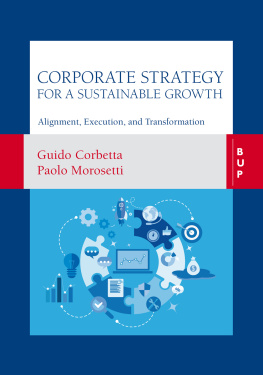Corporate strategy differs from business strategy by the fact that the former aims at building a corporate advantage, while the latter a competitive advantage. Both are intertwined and are crafted not only to find an alignment with the environmental context and companys resources, but also with the ownership model. Two are the main groups of decisions that characterize corporate strategy: Where to invest or divest? How to manage the business portfolio?
This book, rooted in academic research, the teaching experiences of the authors, and their direct understanding of the corporate world, consists of seventeen chapters, which allow readers to learn how to analyze and evaluate a corporate strategy; how to make and implement growth or divestiture decisions; how to manage M&A processes; how to design the organizational structure to translate a portfolio strategy into sound results; how to implement an effective corporate governance, and how to guide a strategic and organizational change.
Written for students, managers, entrepreneurs, owners, board members, and advisors, this book provides concepts, methods and practices to make good corporate strategy decisions in firms of any size, whose boundaries can cross multiples industries and geographies.
Guido Corbetta is Distinguished Professor of Strategy and Entrepreneurship at SDA Bocconi School of Management and Full Professor of Corporate Strategy at Bocconi University, Milan. He has authored or co-authored several books and articles which have appeared in national and international journals and for which he has earned the 2019 Annual Award for Research Impact at Bocconi University.
Paolo Morosetti is Senior Lecturer of Strategy and Entrepreneurship at SDA Bocconi School of Management and Contract Professor in Corporate Strategy at Bocconi University, Milan. His research activities focus on growth strategies, decision-making models and processes to use and implement corporate strategy decisions, and the management of family businesses.

CORPORATE STRATEGY
FOR A SUSTAINABLE GROWTH
Alignment, Execution, and Transformation
Guido Corbetta
Paolo Morosetti
Translation: Andrew Spannaus
Typesetting: Laura Panigara, Cesano Boscone (MI)
Cover: Cristina Bernasconi, Milan
Copyright 2020 Bocconi University Press
EGEA S.p.A.
EGEA S.p.A.
Via Salasco, 5 - 20136 Milano
Tel. 02/5836.5751 Fax 02/5836.5753
All rights reserved, including but not limited to translation, total or partial adaptation, reproduction, and communication to the public by any means on any media (including microfilms, films, photocopies, electronic or digital media), as well as electronic information storage and retrieval systems. For more information or permission to use material from this text, see the website www.egeaeditore.it
Given the characteristics of Internet, the publisher is not responsible for any changes of address and contents of the websites mentioned.
First edition: June 2020
ISBN Domestic Edition | 978-88-99902-66-7 |
ISBN International Edition | 978-88-31322-02-7 |
ISBN Digital International Edition | 978-88-31322-21-8 |
ISBN Digital Domestic Edition | 978-88-238-1919-1 |
Print: Logo S.r.l, Borgoricco (Padua)
Table of Contents
Introduction
We decided to write this book with three goals in mind:
To reflect on how to make good corporate strategy decisions, building on sound theoretical contributions.
To broaden the awareness of the importance of such decisions for the sustainability of firms of any size.
To help firms thrive and transform through the implementation of new corporate strategy models, rather than only through new business models.
We distinguish corporate strategy from business strategy by the fact that the former represents a system of decisions and actions aimed at building a sustainable corporate advantage, while the latter represents a system of decisions and actions aimed at building a sustainable competitive advantage.
This distinction marks a difference that is worth noting: a corporate strategy is focused on the entire firm the multi-business firm while a business strategy is focused on a single business. Therefore, there are two levels in strategic decision-making with the corporate one placed hierarchically higher than the business one. Of course, there are strong interrelationships between them and, in order to achieve excellent performance, both strategies must dialogue, as will be explained in the course of this book.
Corporate strategy decisions are divided into portfolio strategy and parenting strategy decisions. Dealing with portfolio strategies allows to choose the businesses in which to invest, the new businesses in which to enter, and the businesses from which to totally or partially divest. Dealing with a parenting strategy allows to decide the corporate governance model, the fundamental organizational choices, the role of the corporate headquarters and how they operate, and the leadership system.
This book has been written for various readers:
Entrepreneurs who are motivated to promote the firms growth in the long term.
Corporate strategists leaders and top managers who want to diversify and internationalize the firm where they are working.
Members of boards of directors who are keen to contribute to the strategy process.
Owners who would like to play their role in an active and responsible way.
Consultants who assist firms in formulating and carrying out corporate strategy decisions.
Financial analysts whose job is to value firms and give recommendations to buy or sell their shares.
Students in undergraduate, graduate, post-graduate and specialization courses, such as MBAs and Executive MBAs.
On a theoretical level, our thinking is placed in the domain that investigates how to make and implement good strategic decisions. On that regard, we are thankful to those who have developed remarkable theories we have broadly employed in writing this book, such as the profit maximizing and competition based theory, the resource-based view, the transaction cost theory, the stakeholder theory, the contingency theory, and agency cost theory.
We have also tried to introduce some new elements to the debate in this field. In a nutshell, such new elements can be summarized as follows:
We developed a model for evaluating and appraising corporate strategy decisions that integrates the financial dimension with the environmental and social ones. We dont believe that decisions of this nature can be taken just by considering a single number as the shareholder value approach suggests. They must be rooted in a multidimensional approach and must be contextualized in broad time horizons. In other words, it not enough to make profit, it is also important how to make profit.
We attributed a relevant importance to growth decisions in our thinking, because too many firms have huge untapped growth potential to leverage and drive success.
We considered the interplay between corporate strategy, ownership, and corporate governance. In firms with strong ownership, such as family-owned firms, corporate strategy decisions can be influenced by the activism of vocal owners. In firms with weak ownership, such as public firms, the board plays a crucial role in providing strategic guidance and monitoring the leadership and top management. In addition, an effective governance prevents some people from extracting individual benefits or perks instead of working to maximize the firms interests.







